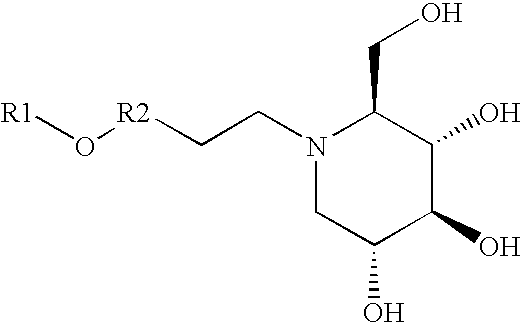Synthesis of nojirimycins
a technology of nojirimycin and nojirimycin, which is applied in the field of synthesis of nojirimycin, can solve the problems of low overall yield of 20% or less, among the most expensive treatment methods for gaucher's disease, and achieve the effect of less was
- Summary
- Abstract
- Description
- Claims
- Application Information
AI Technical Summary
Benefits of technology
Problems solved by technology
Method used
Image
Examples
example 1
Improved Coupling of 1-Deoxynojirimycin and Aldehyde 2
[0040]
[0041] A reaction flask was charged with 2 (3.20 g, 12.8 mmol), ethanol (100 mL), 1-deoxynojirimycin hydrochloride (1-DNJ.HCl, 1.70 g, 8.53 mmol), glacial acetic acid (AcOH, 0.5 mL) and NaCNBH3 (804 mg, 12.8 mmol), under dry N2. After stirring for 48 h, the mixture had become a milky white suspension. The solvent was removed and the off-white glassy residue was taken up in 50 mL of 5% HCl, resulting in gas evolution. The resulting soapy mixture was neutralized to pH 7.5 using solid Na2CO3 and then extracted with CHCl3. The combined extracts were passed through celite and the solvent removed to afford an off-white glassy solid. Purification on a 350 g silica gel column, using a solvent mixture of 700 mL CHCl3, 200 mL methanol, and 20 mL of 28% NH4OH, followed by solvent removal gave 1 (2.41 g, 0.606 mmol) in 74% yield.
example 2
Coupling of Tetrabenzyl 1-Deoxynojirimycin and Aldehyde 2
[0042]
[0043] A flask was charged with 2 (143 mg, 0.573 mmol), tetrabenzyl-1-deoxynojirimycin (Vb, 200 mg, 0.382 mmol, prepared from 2,3,4,6-tetra-O-benzyl-D-galactopyranose (Pfanstiehl, Waukegan, Ill.) according to Matos, C R R; Lopes, R S C; Lopes, C C. Synthesis, 1999, 4, 571-572,) and 1,2 dichlorethylene (6 mL), and the mixture was allowed to stir for 15 min, at which time Na(CH3CO2)3BH (0.324 mg, 1.53 mmol) was added in one portion. The resulting mixture was stirred for 3 h. Subsequently, 25 mL of sat aq NaHCO3 and 25 mL of CHCl3 were added. The organic layer was dried and the solvent removed. The resulting orange oil was purified on a silica gel column using 10% ethyl acetate in hexane as the solvent to afford compound 1b (170 mg, 224 mmol) in 59% yield.
example 3
Deprotection of Tetrabenzyl Compound 1b to form Compound 1
[0044]
[0045] A dry flask was charged with Li (196 mg, 28.2 mmol) under dry N2, cooled to −78° C. and 30 mL of liquid NH3 was condensed into the flask. The mixture was stirred until the Li dissolved in the NH3 to afford a blue solution. Subsequently, a solution of compound 1b (150 mg, 0.198 mmol) in dry tetrahydrofuran was added via syringe. After 10 min, an additional amount of Li (196 mg, 28.2 mmol) was added. After 3 h, the mixture was allowed to rise to room temperature and the NH3 was allowed to evaporate under a stream of N2. The residue was combined with 20 mL of H2O, followed by addition of an ion exchange resin (10 g, Dowex 50W-X8 100) and the mixture was stirred for 2 h. The resin was filtered and washed with 1 N NH4OH (20 mL) and 7 N NH3 in methanol. The combined aqueous fractions were extracted with ethyl acetate. Drying and solvent removal of the organic extracts afforded compound 1 (43 mg, 108 mmol) in 55% yield ...
PUM
 Login to View More
Login to View More Abstract
Description
Claims
Application Information
 Login to View More
Login to View More - R&D
- Intellectual Property
- Life Sciences
- Materials
- Tech Scout
- Unparalleled Data Quality
- Higher Quality Content
- 60% Fewer Hallucinations
Browse by: Latest US Patents, China's latest patents, Technical Efficacy Thesaurus, Application Domain, Technology Topic, Popular Technical Reports.
© 2025 PatSnap. All rights reserved.Legal|Privacy policy|Modern Slavery Act Transparency Statement|Sitemap|About US| Contact US: help@patsnap.com



